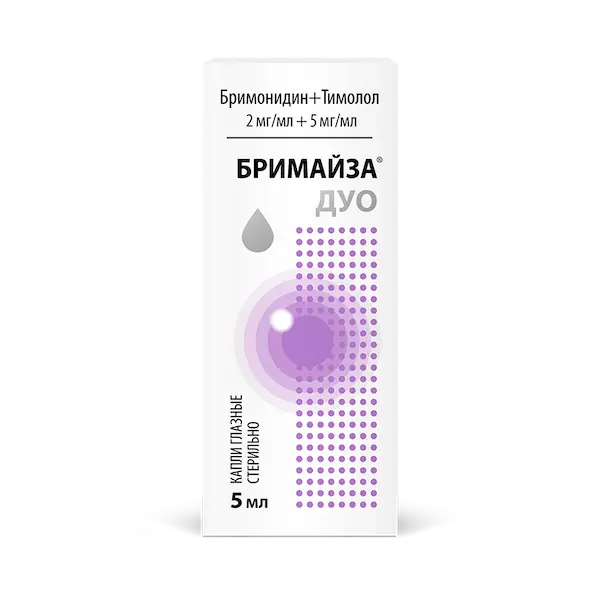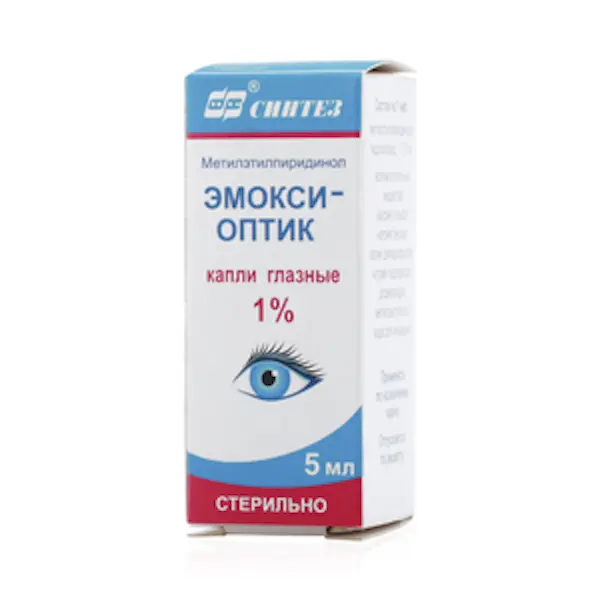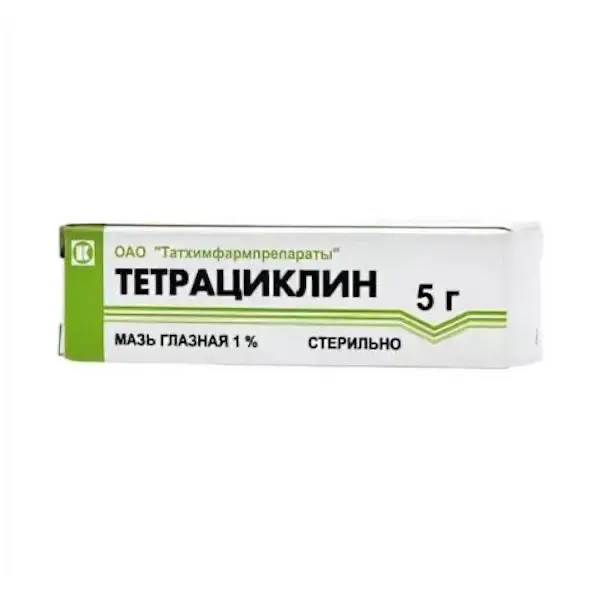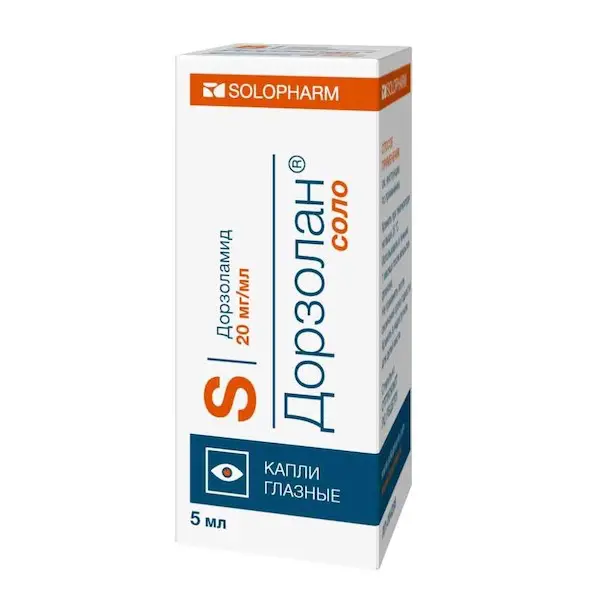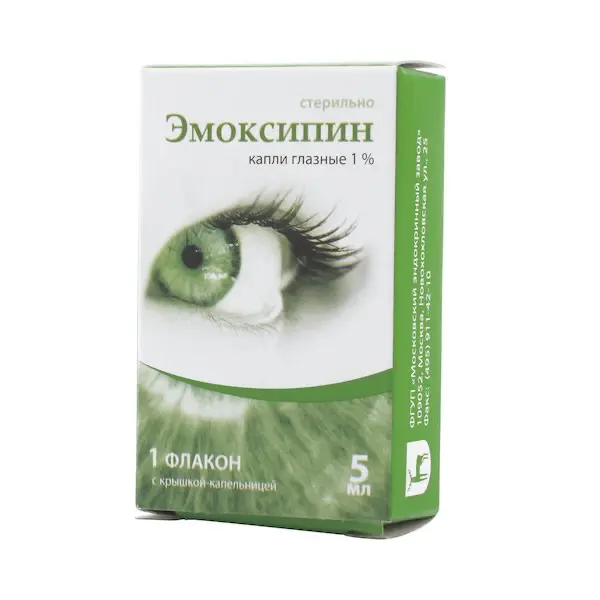Description
Brimaiza Duo Pharmacodynamics
Brimaiza® Duo is a combination medicine containing 2 active substances: brimonidine is an adrenomimetic with a stimulating effect on alpha2-adrenoreceptors and timolol is a blocker of beta-adrenoreceptors. Both active substances reduce intraocular pressure (IOP) due to their combined interaction, resulting in a significantly more pronounced hypotensive effect compared to the effect of each of the components separately.
Brimonidine is an alpha-adrenergic receptor agonist and has 1000 times greater selectivity for alpha2-adrenoreceptors compared to alpha1-adrenoreceptors. Selectivity is expressed in the absence of mydriasis and vasoconstriction of microcirculatory vessels. The hypotensive effect of brimonidine is provided by reducing the formation of intraocular fluid and increasing its outflow through the uveoscleral pathway.
Timolol is a non-selective beta-adrenoblocker and has no intrinsic sympathomimetic and membrane stabilizing activity. Timolol reduces IOP by reducing the formation of intraocular fluid. The exact mechanism of action is not established; it may be related to inhibition of cyclic adenosine monophosphate (cAMP) synthesis and is caused by endogenous stimulation of beta-adrenergic receptors.
Indications
Open-angle glaucoma.
Ophthalmohypertension (in case of insufficient effectiveness of local therapy with beta-adrenoblockers).
Contraindications
– Hypersensitivity to the components of the drug.
– Increased airway reactivity, including bronchial asthma and episodes of bronchoobstruction, including a history of severe chronic obstructive pulmonary disease (COPD).
– Sinus bradycardia, sinus node weakness syndrome, sinoatrial block, grade II-III atrioventricular block without an implanted artificial pacemaker, heart failure, cardiogenic shock.
– Concomitant therapy with monoamine oxidase inhibitors (MAO),
antidepressants – tricyclic and tetracyclic (including mianserine).
– Age under 18 years of age.
– Breast-feeding period.
Caution
Renal or hepatic impairment (use of the drug has not been adequately studied in this group of patients).
Serious peripheral circulatory disorder/disorder (e.g. severe Raynaud’s disease or Raynaud’s syndrome).
Given the negative effect on intracardiac conduction time, beta-adrenoblockers should be used with caution in patients with grade I atrioventricular block.
In patients with mild/moderate COPD.
Beta-adrenoblockers should be used with caution in patients with existing signs of spontaneous hypoglycemia or in patients with unstable diabetes mellitus, because beta-adrenoblockers may mask the signs and symptoms of hypoglycemia.
Brimaiza Duo should be used with caution in patients with metabolic acidosis and with pheochromocytoma (without previous treatment).
Corneal diseases and “dry eye” syndrome (see section “Special indications”).
Administration during pregnancy and lactation
No controlled studies have been conducted to study the use of Brimayza® Duo in pregnant women.
Brimonidine
There are insufficient data on the use of brimonidine in pregnant women. Animal studies have shown the presence of reproductive toxicity of high doses of the drug to the maternal body. The degree of risk to humans has not been established.
Timolol
Animal studies have established reproductive toxicity when using doses of the drug significantly higher than those recommended for use in clinical practice. However, epidemiological studies have not revealed congenital fetal malformations, but the risk of intrauterine fetal retardation is known from the oral use of drugs of the beta-adrenoblocker group. In addition, symptoms characteristic of the beta-adrenoblocker group (bradycardia, decreased blood pressure, dyspnea, and hypoglycemia) were observed in newborns in cases where beta-adrenoblockers were used by the mother up to the time of delivery.
Therefore, if Brimaiza® Duo is administered during pregnancy until delivery, a physician should monitor the newborn during the first days of life.
Brimaiza Duo is not used in pregnant women unless absolutely necessary.
During breastfeeding
Brimonidine
The possibility of brimonidine penetration into human breast milk has not been established. It is known to be excreted into milk in rats.
Timolol
Beta-blockers penetrate into breast milk. However, when timolol in the form of eye drops at therapeutic doses is used, it is unlikely that clinical symptoms will develop in children because there is not enough of the drug penetrating into breast milk.
Breastfeeding should be discontinued during treatment.
Dosage and administration regimen
- Dosage and administration in adults, including elderly patients
- Topically, 1 drop of the solution is applied into conjunctival sac of the affected eye twice a day at 12-hour intervals.
- Brimaiza® Duo may be used with other ophthalmic drugs to reduce intraocular pressure.
- If more than 2 drugs are used, a 5-minute break between instillations is necessary.
- As with other eye drops, to reduce possible systemic absorption a brief pressure on the lacrimal sac at the projection of the lacrimal sac at the inner corner of the eye or closing the eyelids for 2 minutes is recommended to reduce possible systemic absorption. This should be done immediately after each drop.

